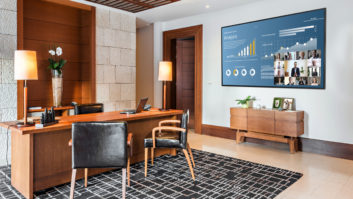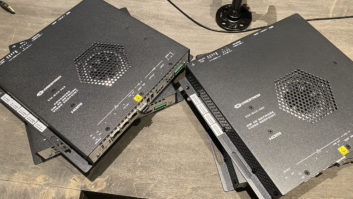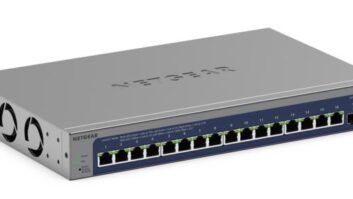Whenever I give a seminar on designing and implementing communications networks for content distribution around the home (as opposed to just installing a more common “data only” network), I inevitably get asked what Ethernet switch I recommend. There are several on the market that support continuous high-definition audio and video streams better than others, and I thought it would be useful to pass on some of the more important considerations I use when designing a content distribution network and selecting an appropriate Ethernet switch.

Netgear’s 24-Port entry-level Gigabit switch
SELECTION CRITERIA
1 Always use a minimum of gigabit-capacity switches. Too many times I see 100 Mbit/s Fast Ethernet-only networks installed, which really limits the amount of data that can flow from a media server or centralized storage device. Also, use at least Cat-6 cable and associated termination components. Cat-6 provides better bandwidth overhead, reduces errors, and potentially supports upgrading to higher speeds in the future when implemented properly.
2 Always use a “managed” switch. This term is a little ambiguous, but it should at least have a web page for configuring specific characteristics of the switch. These types of Ethernet switches always have an IP address for the switch itself. It is important to change this IP address from the default provided by the manufacturer so that if you need to add another switch later, you do not have duplicate IP addresses on the same network. Of course, you want to track all of the static IP addresses as part of your project documentation.
3 Try to use a single, centralized switch whenever possible. Granted, some larger installations require Ethernet runs that are longer than what the 100-meter Ethernet standard allows, but you always want to home run cables back to a single switch in your infrastructure wiring location. If you must use multiple switches, then always use the same vendor and preferably the same model. Also, use switches with specialized high-speed up-link and down-link connectors on them. Do not rely on a “regular,” single gigabit Ethernet link between switches when cascading them. You need to have the highspeed switching fabric of one switch carried across to another one through something like a high-speed GBIC (Gigabit Ethernet Interface Converter) port. Usually these require fiber links for the longer runs.

Derek R. Flickinger is vice president of R&D for Interactive Homes Inc. (www.interactivehomesinc.com) in Drexel Hill, Pennsylvania.
4 Never use the “built-in” Ethernet switch in a broadband router supplied by the MSO as the main switch for the home. Some of them are still only 10 Mbits/s. Even if they are 100 Mbits/s, they are usually the cheapest switches you can find and rarely have the necessary electronics to support media and content streaming. You should use just one of the Ethernet connections on the broadband router to connect it to the better-centralized switch.
5 One of the most important selection considerations is that an Ethernet switch has a minimum of 128K of buffering per port. This is most important when dealing with 100 Mbit/s devices. A high-definition gigabit stream from a media server can easily overwhelm a 100 Mbit/s connection. The lack of sufficient per-port buffering is one of the most common causes of dropouts and video breakups, especially when connecting a MediaRenderer to a higher speed MediaServer.
6 There is one more related criterion that is a bit more esoteric but comes into play for networks using Windows 7-based PCs. Windows 7 now supports what is called Rx/Tx Flow Control. It is turned off by default but can be enabled via the advanced properties for the LAN card in the PC. Microsoft’s testing has found that enabling this configuration option helps eliminate several network congestion issues when streaming high definition content (assuming the switch supports it). Only enable Tx Flow Control if you are sure your Ethernet switch supports this on a per-port basis.
With all of that said, a good Ethernet switch to consider is something like the 24-Port Netgear entry-level Gigabit switch from its GSM line (at about $700). There are several other good Ethernet switches available on the market if you do your research, but one of the nice things about the Netgear line is that they actually list all of the pertinent specifications on their website and in their marketing materials, which makes it a lot easier to evaluate them.
Selecting the right Ethernet switch can help increase your success rate and reduce future service calls. Take the time to do your research and definitely stay away from the “el cheapo” switches that you can pick up at any hardware store. If the foundation of your network does not have the right capabilities, nothing riding on top of it will work well either.







